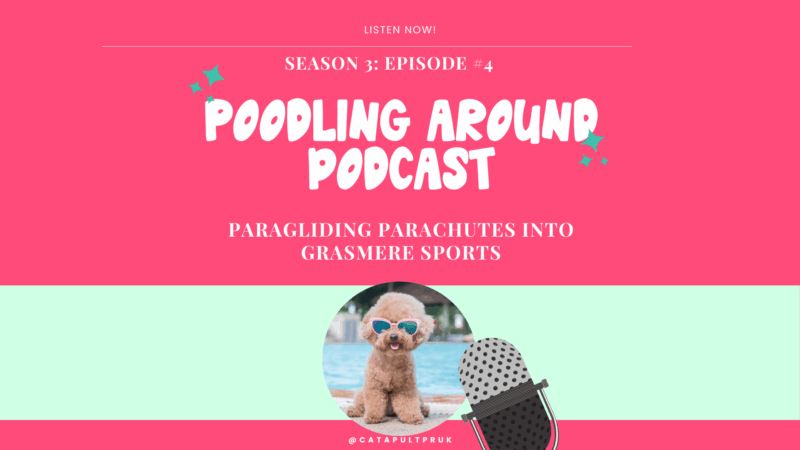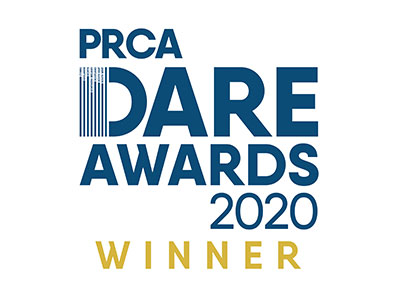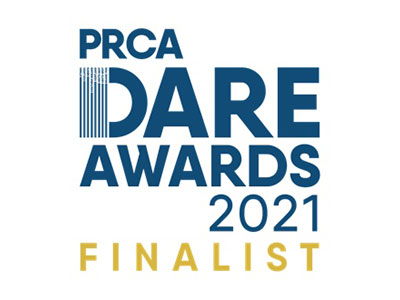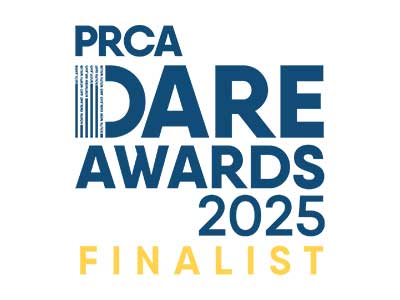
September 23rd, 2025
Paragliding Parachutes into Grasmere Sports
Podcast: Play in new window | Download
Subscribe: RSS
Ahead of the 2025 Grasmere Lakeland Sports and Show, which she is promoting as part of her travel PR and tourism PR, Jane Hunt talks to Paul Abbott. The discussion is all about a brand-new sport that is parachuting into the Grasmere Sports programme in 2025. This is the Grasmere Hike and Fly. It’s a paragliding event that encompasses navigating between waymarks, to land and register a visit and then fly off again, around the course. From there, it’s a race back to the starting point, on the Grasmere Sports showfield.
Jane, promoting this event for the 4th time with her company, Catapult PR, discovers why this is such an appropriate and suitable sport for inclusion at Grasmere Sports. She also gets to the bottom of what it will take to win the paragliding race. And she asks who is competing and what the aim of putting this race on this year actually is.
Opportunities to get involved in other ways are also explored and Jane and Paul both hint at plenty of other reasons to visit the show in 2025 specifically and in a future year, if you can’t make it this year.
Transcript of the Grasmere Sports, Grasmere Hike & Fly Paragliding Episode
Speaker A: Hello Poodling Arounders.
If you have listened to previous year’s podcasts, you will know that Grasmere Lakeland Sports and Show is an event greatly associated with Cumberland and Westmorland wrestling, fell running and hound trailing.
This year’s event taking place on Sunday, August 24th will have lots of drama and expectation woven into it.
The Breton wrestlers from Brittany in France are riding really high at the moment and they have high hopes in around four wrestling weight categories.
Meanwhile, the Icelanders will be bringing the four time Queen of Glima, their form of backhold wrestling.
In the U17s fell race. We have a real cliffhanger because it’s the 50th anniversary of the record set by Graham Moffat of Sedbergh in the 1975 race, in a year when Blue Peter’s John Noakes took part in both wrestling and fell running at Grasmere. I have to say he didn’t fare very well. But look it up.
That record of Graham’s is even older than that of Fred Reeves in the Seniors Guides race where his time from 1978 has long been a target.
So could these records fall this year?
Or is it the case that in fact the famous multi-year rivalry between Fred Reeves and Tommy Sedgwick, who I interviewed two years ago, was a factor that inspired all of this record breaking?
Graham Moffat certainly thinks so. When I interviewed him for a press story, he told me that, as an under 17 runner, he looked up to Fred and Tommy as icons who he wanted to emulate.
We see this at times, don’t we?
Think of Sebastian Coe and Steve Ovett.
Maybe there really is no substitute for top rivalries when it comes to inspiring performance.
So you know all of this about Grasmere Sports, if you’ve tuned into past episodes, but what about paragliding?
Do you associate that with the Grasmere sports event?
Well, today’s guest, Paul Abbott is hoping that you soon will after what he’s instigated this year.
Let’s find out more.
Speaker A: Hello Paul, how are you today?
Speaker B: I’m very well, thank you, Jane. Yes, it’s Friday afternoon, I’ve finished all my work for the day and it’s the weekend so yeah, I’m very cheerful.
Speaker A: Oh great, good to hear.
Now we have Grasmere Lakeland Sports and Show coming up on Sunday, August 24 this year.
But amidst the Cumberland and the Westmorland wrestling, the fell running and the Hound racing, we’ve got something new this year, haven’t we? Could you tell us what that is, please?
Speaker B: Sure. Okay, so I’M a member of the Cumbria Soaring Club, which is the paragliding. The oldest paragliding club in the country, but is the, the paragliding club for Cumbria.
And we’re organising what’s called a Hike and Fly race, which is a race where individuals. It’s very similar to the fell race, the traditional fell race at Grasmere Sports, where people have to run up the hill to begin with,but the twist is they carry a paraglider on their back and they will fly off the top and they’ll probably have to fly to a few hills to tag different Wainwrights, different peaks around the Grasmere Fells, around the showground, before flying back down and racing back into the finish line.
So it’s kind of like a fell race, but you can fly as well.
Speaker A: I see. So this is taking place in the skies above the whole Grasmere area and a little bit beyond, I guess.
So over what sort of distance is that likely to be?
Speaker B: Well, that’s a great question. I wish I knew that.
It really does depend on the weather.
So we’re. You can only fly in the. In dry weather and also in light winds. And you can’t fly in the cloud either. It’s, it’s very. Well, I mean, you, you can on a physical level, you can fly in the cloud, but it’s really discouraged.
It’s not safe to do so because you can’t see where you’re going and you can easily fly into the side of a mountain or something or into each other.
And so really what, they’ll only be flying if it’s calm, clear weather and dry weather. And so if there’s a flying element on the day, and there’s very. And there’s a very high cloud base, like a cloud base at say, four and a half thousand feet. With good weather, we might plausibly fly 50 kilometres around a big circuit.
But if it’s a very different day, you know, a day with rain showers or a day with higher winds, we might only manage a small amount of flying. And so we might be more like a sort of 10, 15 kilometre sort of race. So it really does depend on the weather.
Speaker A: Now, looking at the forecast, it doesn’t look too bad at the moment. So let’s hope it’s going to be good weather this year.
So what’s going to, what’s it going to be like for the spectator? What are they actually going to see from the Grasmere Sports show field?
Speaker B: Okay. So they can see the spectacle, they can see the. Similar to the hound trails. I mean, so when people watch their hound trails, the hounds kind of race off out into the fells and then you see them piling back in at a certain point and you tend not to see them in the middle bit when they’re sort of following the circuit around.
We’ve tried to fix that. I mean, the same is true with the paragliders. Basically, the paragliders are going to race out from the pavilion and they’re going to race up the hill and then hopefully we’re going to design the circuit so that people will be able to see them floating around the skies around the amphitheater of the Grasmere Valley.
So, and paraglide is generally a quite colourful. They tend to be bright coloured wings and quite big wings. I mean, I fly a paraglider that’s 30 square meters, for example. So it’s quite a large area of canvas.
And I’m hoping that you’ll be able to see these people sort of bobbing around the valley all day, hopefully. And then obviously we’re also going to have a race back to the finish line once people have landed.
So they’re going to need to tag certain peaks, stand on the summits of different peaks around the Grasmere Valley, and then race back to the finish line. So we’re also going to do a GPS tracking. This is something new for this year. This is partly for safety because we want to be able to know where all the pilots are at any moment in time.
But we’re thinking of putting this GPS tracking up on a big screen so that people can kind of follow live the progress of the individual pilots and how they’re getting off.
Speaker A: Oh, that’d be great because that will add a bit of interest throughout the day, won’t it, if they can see that happening. So at what time is this initial dash out of the pavilion?
And at what time do you expect the main contenders to be arriving back?
Speaker B: So I think that we will be running out of the pavilion quite early, sort of about 10.30 kind of time. And the reason for this is a paraglider is quite a heavy piece of equipment. So generally speaking, I mean, you get lighter versions and heavier versions and so on, but generally Speaking, it’s about 10 to 12 kilograms of weight on your back.
And so no one’s really running uphill, you know, so we need, we need about a good athlete, a good, a good pilot who could carry. Could get to the top of Heron pike in an hour, for example, and you could be on Fairfield in an hour.45,
just walking with the paraglider on your back. So we need to start early to give them time to position themselves to be at a good time for takeoff.
And generally speaking, the sun warms the ground in the morning, and then by about lunchtime, by about sort of 12 o’clock, the warm air, the sun is warm and started to rise up and create thermals, and we can take off into those thermals and ride those currents of rising air up towards the clouds.
And that’s how we can stay up and then use that height to travel and glide around the valley. And so I think we’ll aim to set off about 10:30, give everyone about an hour and a half to get to take off, and then I think they’ll be expected to be back by about 2:30. I would, you know, roughly.
And the goal there is we want to set a reasonable course, a course that’s achievable for people in that kind of two and a half, three and a half, four and a half hour kind of window.
But equally, we, we understand, like, if, for example, you miss a thermal or you get something wrong and you end up landing out and you have to walk all the way back, we want you to be back before it gets dark,you know, so we’re going to have to try and keep it reasonable on the finish time.
Speaker A: Certainly, yes, we do our best not to lose hounds, but we certainly don’t want to lose paragliders, do we?
Speaker B: Well, yes, exactly. And also, if you go down in the wrong valley, I mean, the Lake District is so complicated.
You know, imagine that if you, if you went over Helvellyn, for example, there’s a lovely ridge running up from Grasmere all the way to Helvellyn. But if you end up getting blown over the back of that ridge and landing in Ullswater, actually, it’s a really long way back, even with a. Even in the bus. You’ve got to get a bus down to Troutbeck and then the bus change buses and then come all the way back. You’d be hours just getting home.
And so we’ve got to be a little bit careful that we get people back on time.
Speaker A: Yes, indeed. Now, how many of these competitors are there going to be and what level of paraglider are we talking about here?
Speaker B: Right. Well, this year we’ve kept things relatively small. I mean, there’s been paragliding of some kind or other on, you know, associated with Grasmere Sports really for the last, I don’t know, 25 years or something. So that Sort of order of magnitude anyway.
And really that. I mean, the sport isn’t very old. I should emphasise that it’s a very new sport. The technology.It used to be hang gliders. In the 80s and the 70s it was hang gliders. But they’re very heavy and hard to move around the hills. And paragliders were invented as a kind of lightweight version of that.
And so there’s only 12 of us this year. It’s still a very small sport. That’s the thing I want to emphasise. So there’s. There’s 12 people taking part.
They are mostly Cumbrians. People who live in Cumbria, work here and are doing this in their spare time. We do have. And that doesn’t mean that they’re amateurs, though. We have a couple of people taking part who are professional or semi professional in the national team.
There’s a young lad called Jacob Aubrey who’s taking part, who’s in the great British team and represents the UK paragliding overseas.
We also have Dave Ashcroft, who’s our head coach for the Cumbria Soaring Club, taking part. And he’s a very, very experienced paraglider. He’s been paragliding as long as the sports existed, basically, and is probably one of the best paragliders in the country, I would suggest with most experience, certainly.
So. But we’re such a small sport, you know,
it’s still in the kind of golden age where it’s possible for relatively ordinary people to compete at a high level because there’s so few of us doing it.
Speaker A: So it sounds like they’re elite, but they’re not necessarily elite as we would think of elitism in other sports. Maybe it’s just.
Speaker B: Well, yeah, so they have jobs is the point. They’re not professional. So the people who were competing for the UK in the national team or whatever, they.
There’s no money in paragliding, you know, they’re paragliding to a very high level. I mean, Jacob is a good example. He’s. He’s a young lad. He’s representing the UK all the time with his paraglider and hike and fly competitions in Europe and elsewhere.
But he’s got a job, you know, and so. But that’s fun. I mean, it’s sort of like how football used to be, like in the early 20th century, do you know what I mean?
Where there wasn’t the big money and so on. And I think it’s probably true of rock climbers and lots of other mountain sports too, that there really isn’t the same level of funding or money in these sports.
But there’s also a kind of romance to that, I would suggest. I mean, just to. Not to obsess about him, but just to take the example of Dave Ashworth, for example.
Dave is from St Bees. He worked at Sellafield his whole career. He was a quantity surveyor and helped keep the power plants going and whatever, and no one would know to meet him or whatever.
He’s also a phenomenally talented and experienced paragliding pilot. He just is. That’s his hobby, you know, that’s what he does in his spare time.
Speaker A: And you’ve got these 12 people this year. But is the idea to kind of expand that? You know, is this a test bed for what could happen in future years? It could be perhaps bigger, with more people involved.
Speaker B: Yes, it is. I mean, and we’ve got some people who are good examples of that. So there’s another pilot involved called Tom Hodgkin, for example, who’s just started to be sponsored by Gin.
The manufacturer, the paragliding manufacturer. He’s another guy who works in Cumbria. Lives in Cumbria.
He puts up teepees for weddings. It’s his job. That’s. He runs an events business in Cumbria, but again, in his, like, in his spare time, is like a nationally recognised paraglider.
And he, I think, is a good example of someone who could help us recruit more people to this race and to promote this at a higher level. I personally would like to see this become like a modern version of the Senior Guides Race.
If you think about what the Senior Guides Race was back in the day. So the main fell race, it was the first fell race ever in the UK, as far as I can make out. And the Senior Guides Race was all the people who were professional mountain guides sort of competing with each other to prove who was the best.
Right. Who could get up to Alcock Tarn and down the fastest. And the truth is, now if you go to the Alps and you get someone to take you up Mont Blanc, most of the Alpine guides are also paragliding pilots because it’s much easier.
You don’t have to walk down. Right. It’s a lot. It’s a lot simpler. And so the modern paragliders are just tools for mountaineers to use to move around the mountains more efficiently and in particular, to descend more efficiently.
It’s a lot safer to come off a big mountain in 25 minutes with one long glide than it is to scramble down over a glacier in the dark over difficult terrain and so on.
And so the mountaineering serious mountaineering in the Himalayas and the Alps is really moving towards paragliders. And I think if. If you were to invent the Senior Guides race today,
it would probably involve paragliding in some form. You know, this is a kind of. This is a safer and more efficient and more cheerful way to move through the skies, I would suggest.
Speaker A: Yeah, that’s a good way of looking at it, isn’t it? You know, it’s a solution for these people in the mountains. It’s.
Speaker B: Well, yeah, if you don’t enjoy coming downhill on your knees, take up paragliding. That would be my number one recommendation for sure.
Speaker A: And I just want to emphasise here, because paragliders have floated over the show field in the past, haven’t they? There has been some sort of paraglider involvement, but this is completely different, isn’t it?
This race is something that we haven’t seen before.
Speaker B: Yes, well,
it’s different in a few ways. The first is that there’s quite a high level of competitor entering. It’s been taken relatively seriously and it’s not just free flying, so it’s paragliding with an objective.
In the past, I think there’s been some air displays and there’s been what we call boating around, which is basically where you fly off and you just sort of float around in front of the hill and have a lovely time.
And that’s nice to look at and it’s nice to do, but it’s not really mountaineering in the way that hike and fly is. The purpose of hike and fly, which is a kind of subset of paragliding, if you like, is to use the paraglider as a tool for exploring the mountains.
That means. So, for example, I mean, you have to know the topology of the Grasmere Valley to understand what I’m about to say. But imagine if you walked up Heron Pike, which is the mountain just behind the show field, but you wanted to also get up the ridge to Seat Sandal or to Fairfield.
You could just walk there.
Or if you had a paraglider with you, you could take off and the wind that was hitting the side of the ridge would lift you up and then you could float along.
And on a paraglider, you’ll move at 30 miles an hour if you. If you want to, rather than walking at four miles an hour. And so it’s a totally different. It’s a totally different game to try and get high on the. On the paraglider and then to fly along the ridges and then to land again and to do.
There are some bits that are easier on foot and there are some bits that are easier in the air. And it’s a, it’s a way of moving through the mountains efficiently.
And also, for example, there’s a big walk in the Lake District, you know, the Three Peaks. Lots of people every year try and attempt the Three Peaks. So Skiddaw, Helvellyn and Scafell Pike all in a day. That’s quite hard to do in a 24 hour period.
And people tend to do it around June, when the solstice, you know, when there’s lots of daylight. There are lots of people in the Cumbria Soaring Club who’ve done the Three Peaks on a paraglider in a few hours.
Because if the wind is right and the weather is right and the cloud base is high enough and you’re moving at 30 miles an hour, you can do it really quickly. Right? And the same is true that Tom Hodgkin, who I mentioned earlier, he’s taking part this year.
He was the first person to complete the Bob Graham Round on a paraglider.
Now the Bob Graham Round is, you know, probably the hardest or one of the hardest, certainly circuit routes in the Lake District. It’s very, very sought after by serious fell runners.
And Tom, I think even he would say, is averagely fit, but with a paraglider, he did the whole thing, I think, in 15 hours, which is a phenomenal effort because you’re just so much more efficient even carrying the extra weight.
Your ability to cross valleys without losing height, it’s really just a different sport,I would suggest.
Speaker A: And how do you think this is going to be received by the people, the crowds that turn up?
And do you think it’s going to bring in new people who perhaps have never visited the show before?
Speaker B: Okay, so that’s a good question. I hope that people enjoy, even if they don’t know anything about paragliding and think it’s all lunacy, which, you know, there’s a case, there’s a good case for that. But I hope that it’s at least pleasurable to watch.
The. It’s really. I want to emphasise that paragliding, the type of paragliding we do, which is cross country paragliding, really has a very good safety record and it is very gentle and you can fly the wing slowly.
So if you apply the brakes to the wing, you fly at maybe 10 to 15 miles an hour. So you’re about the pace that you could jog at, for example, that’s very different to BASE jumping or Speed flying or these much more adrenaline based air sports that involve people moving at much higher speeds and which much more G force and so on.
So I think that the. I don’t know if many people will be tempted to try it, but I really think that if I can do it, anybody can do it.
And it’s much more gentle than perhaps people would expect. It’s much more scenic that it’s not sort of. It’s not really an adrenaline junkie sport. It’s really very relaxing to do and I hope maybe that we inspire some people to give it a go in the future if they,
if they enjoy the Fells and they don’t like walking downhill and they want to sort of ride around the sky. It’s the closest thing you can get to skiing in the Lake District.
Basically. We’re never going to have skiing here really on a big scale other than perhaps half a week in February. But paragliding we can do all year round and it’s really the closest thing we can get.
But if they won’t, if they aren’t tempted by that, if nothing else, hopefully it will just make a beautiful spectacle for people to watch as they’re enjoying the rest of the show.
Speaker A: Yeah, and people may think that Grasmere Sports has only really featured three sports.
Athletics/fell running, hound trailing or racing as it’s now known, and Cumberland and Westmorland wrestling. But that’s not the case, is it? Because over the years and over the decades there’s been quite a few different things that have entered the programme.
Speaker B: Yes, I think that there was quite a good foray into mountain biking for a bit. I think that was quite a cheerful.
At least that’s my memory. I mean I’ve been coming to the sports since I was about 5 years old on and off and I’m now 39. So how many years is that?
I don’t know but the. Yeah, I remember, I remember there was a period of, of mountain biking. I think there might be some cycling in the future again if we can persuade.
You know, even if it’s just track cycling, the athletics also is really fun.
I remember doing the. Some athletics that’s more so track racing rather than fell racing as a kid. I’ve also, I mean, embarrassingly, I’ve always been a big fan of the beer tent.
I’m there for the beer tent, you know, and there’s, there’s lots of sort of fun things on the day like that also the, the thing that it’s not really a sport as such, but the Dog show, I think, is justifiably popular and has been getting bigger and bigger in recent years, and that’s really sort of jolly and cheerful. And so there is. There is this sort of long tail of other things that are either popular locally or have been sort of going on in the Lake District for a long time.
Um, and in the case of the paragliding, obviously, it’s really relatively recent. It. It didn’t exist until the last few decades. And so it’s kind of a. A bit of a. A quirk of history. We just happen to be living through this period of time when it’s being invented, you know.
Speaker A: You forgot the pole vault there, Paul.
Speaker B: Oh, the pole vault. Sorry, the pole vault. Yes. I guess that would be athletics, maybe. But, yes, there was. I. I think I’ve seen.
I’m not really a pole vaultist. I. I confess it’s. I. It’s probably not my natural ability, but there must be people who’ve loved the pole vault over the years, I feel.
Sure.
Speaker A: Yeah. I mean, that must have been quite incredible when we had that.
But I think. I seem to recall that maybe pole vault was invented in Ulverston. So I think it.
Speaker B: Right.
Speaker B: I don’t know.
Speaker B: I have seen a video. There is a great video on YouTube of the pole vault at some point in the early 20th century, I think, of these. They’re mostly lads, but there’s some ladies doing it, pole vaulting.
And there’s no crash mat. You just had to be good enough to land on your feet because that was how. That’s how it was back in the day. Do you know what I mean?
That’s. That was just what was done. And so, yeah, I think they. Probably the health and safety people,maybe.
I don’t know. The pole vault had to modernise and there are still pole vault stands and things in the pavilion. I think the old ones, the old bamboo ones. I’m sure I’ve seen them in there.
Speaker A: Oh, Hardy Cumbrians landing on grass.
Speaker B: Yeah, I mean, I honestly, if you do one thing after listening to this podcast, I really encourage you to go on YouTube, like Grasmere Sports from the 20th century There’s some old videos on YouTube and they’re really. Most of them are of pole vaulting, actually, and it looks wild.
Speaker A: I don’t think we’ll be bringing that back.
Speaker B: No, well, sadly not. No.
Speaker A: I won’t be doing crisis PR for any injuries and.
Speaker B: Yeah, yeah.
Speaker A: Exactly how important do you think it is to keep diversifying the program by introducing new things?
Speaker B: That’s a good question. It’s similar to sort of the question about the Olympics. The modern Olympics, which is less, is more recent as an invention than Grasmere Sports, I’d like to point out Grasmere Sports is older than the modern Olympics, but the. The Olympics tries to do this every few years and I think some.
Sometimes it’s been successful and sometimes it hasn’t. So that’s just my personal opinion. But if you think back, I really enjoyed watching the rock climbing in the Olympics, the most recent one, whichever one it was, that was really good to watch.
And some of the climbers are very. I mean, and England was doing really well at that and we have some great climbers and we were. It was really good television.
I’m not sure that the golf grabbed me and there’ll always be some duds and perhaps other people love the golf. I don’t know. It’s just not really my cup of tea.
Can’t you like, why have it on the Olympics? I wasn’t convinced by that. So I think there is a positive reason to add new things and to try new things.
Not all of them will work. Some of them will be duds or overly complex or not quite right for the event or whatever.
I don’t think that Grasmere Sports would be better if we suddenly had the Ryder cup in the middle of it. Do you know what I mean? I’m not sure that that would.
That would make sense, but I think that if. If they’re mountain sports,
it makes sense. I would love to see swimming. There’s a really good and cheerful scene of wild swimming at the moment in Cumbria. Lots of people in the Great north swim is a good example.
Around Windermere, lots of people are going out in the tarns and other things, and I would love to see that represented somehow. The truth is you have to get the clubs themselves, the sports clubs themselves to.
To run these events. It’s not possible for the sports committee to personally run individual contests. The individual sports clubs need to do it. But I think swimming would be cool to see.
I also think some more cycling. Lots of people come to the Lake District now to cycle here, either on the roads or in the mountains, and I’d love to see that represented somehow. And I think also this year, which I think we used to do a lot of, and then it sort of fell into abeyance, but it’s coming back a bit, is more of the. Of the young farmers and seeing what the young farmers are up to across Cumbria. And I think that’s important too, because they’ve had a bit of a Rough time recently and it’s nice to see that side of Cumbria being supported and celebrated really.
I’m not sure that every sport will work, but some of them for sure.
Speaker A: I don’t think we’ll be looking at breakdancing, will we?
Speaker B: Yeah, yeah. But things that are genuinely local and that people really come here to enjoy I think are worth looking at definitely.
Speaker A: And you know what’s so good about paragliding in Cumbria? Because it is a bit of a centre for paragliding, isn’t it? Is it just the terrain? Is that what it is?
Speaker B: Yeah, well, there’s a few things I would say. There’s basically two reasons. The first reason is. Yes, exactly. As you say, the terrain, you need to always. It’s certainly a lot easier if you have a hill. It is possible to be towed up to a great height. But that’s not really how the sport began.
The sport began with people walking up hills and jumping off of parachutes basically.
And most. I mean the. There’s a guy called Mike Cavanagh who is a member of the Cumbria Soaring Club and he lives in Cartmel and he runs the biggest paragliding manufacturer in the world, which is Ozone. And he. Not quite single handedly, but he was one of the very early adopters of the sport, basically inventing paragliding. And that happened here in Cumbria. And most of the big early flights were done by people like him and Jockey Sanderson and Patrick Holmes.
And these are all guys who live and work in Cumbria. And Cumbria is basically where paragliding was born in the uk.
And like all these things, we don’t make enough of that. We don’t remember enough about the history of that. And because it was all so haphazard and sporadic at the time and just people doing it in an amateur way on a shoestring in their evenings or their weekends or whatever. It maybe didn’t get the attention that it deserves. But I think we should be, we should be proud of Cumbria’s part in getting paragliding going as a sport and we should try and hang onto it.
And Grasmere in particular. Grasmere is. There’s a. There’s a particular event called the Lakes Charity Classic which is run on Grasmere Showground actually every year it happens in June because the weather’s slightly better in June and that when it was first held in.
Yeah, that’s. So I should say that’s the oldest continuously running paragliding event certainly in the country. We think in the world that’s still being run that’s actually not that big a statement because it’s such a new sport.
But that was run from Loughrigg originally, which is the mountain just to the south of Grasmere. And if the wind was one way, you would land at Grasmere Showground. If the wind was the other way, you would land at Ambleside Rugby Club.
Right. To see how you got on. But we have a lot of history here of flying and air sports in general, and I want to try and remind people of that and to keep it going, really.
Speaker A: So there’s real sense of place for this sport, then, isn’t there,in Grasmere? It’s not like we’ve just sort of decided to pluck this out of the air and thought, right, let’s put this here. It’s actually got a huge heritage there anyway.
I know it’s not a long heritage, but, you know, there is a reason for it, isn’t there? Which I think is always good.
Speaker B: Yes. When this is the second reason, which is a slightly more negative reason, which I just wanted to come onto. So the first positive reason is like, the terrain is really good for flying, in essence, that there’s lots of thermals, there’s lots of hills to disrupt the wind, and basically you want to.
You want a hill. Imagine the wind is coming along and hitting the hill. The wind, instead of moving horizontally, is turned upwards a bit, and as it turns upwards, it generates lift.
And so if you fly your paraglider in front of the hill in that lifting region, instead of just going down, you can stay up, and that’s. Grasmere is very lucky to have hills facing all different directions. It’s why Grasmere is quite a good place to fly. So no matter what the wind direction, there’s always something you can find to fly in front of. The slightly more negative reason that Cumbria got into flying,
I want to say, is there’s actually not a lot to do here. And I just want to try and be as candid about this as possible. You know, Cumbria in general actually has a quite a long, dark, dismal winter, where the. Really the choices are either you get into mountain sports or you get really into alcohol. Do you know what I mean?Perhaps I should say there’s also television. That’s maybe a third. A third option. But. But one of the reasons that people have got so deeply into mountain sports, I think, is really because of the lack of alternative things to do.
And if they were in London, maybe they’d go to the theatre or whatever, get really into restaurants or something. But in Cumbria, what we have is the hills and that’s a much better alternative than just letting the drinking consume every night of the week, do you know what I mean?
So that’s one of the positive things about sport here, is it really is one of the only things that people can hang a community around that isn’t the pub.
And it’s one of the things we need to keep it going.
Speaker A: We’ll get onto what you do later, Paul.
Speaker B: Oh, yeah, I know it’s slightly odd message coming from me, but I really think it’s important to have things that aren’t just getting drunk and miserable, you know.
Speaker A: Now, is there a favourite going into this race and will different conditions favour one person more than another?
Speaker B: Yeah, I mean, I could. I don’t want to lose your audience at this point. But yes, basically, if it’s a very light day where there isn’t a lot of possibility of flying long distances, the younger, more athletic competitors will do better because they’ll be quicker over the ground. If it’s a very strong wind day with hard flying conditions, Dave Ashcroft will win, basically. And if it’s a very thermic day where it’s technical flying, but it’s possible to fly well but with a high cloud base but not necessarily strong wind, then I would say the best pilots will win. The people who can fly the best, and they would be.
I don’t want to go through and give a long list, but there’s some obvious pilots in that lineup who are very talented pilots and if it’s purely based on flying, they’ll win.
If alternatively it’s a very rainy day and it depends on just knowing the Grasmere Valley really well and not much flying at all, but you just have to know all the little cut throughs, then I’ll probably do all right because I live there, do you know what I mean?
But we’ll see. It really depends on the day and I don’t. It’s hard to say in advance. It also depends how people are treating their fitness. Like if, if ever, if everyone turns up with a big hangover, then all bets are off, do you know what I mean?
But we’ll see.
Speaker A: And what will gain somebody an advantage? You know, if they can sort of see that they’re not far off, what do they need to do to kind of catch up? Can they catch up on the.
Speaker B: Yeah, I mean, you’re every a glider, a paraglider flies a glide ratio of roughly 8 to 1.
So that means for every metre of elevation that you have, you can fly 8 meters.
So basically you have to win in the air. And you, you can’t, let’s say that there’s a 30 kilometre track. You can’t win that by just running.
You have to try and win in the air. And different pilots favour different types of flying. You know, some people are better at thermic flying where you fly in circles in rising air currents. Other people are better in strong wind flying where you’re ridge soaring or whatever. And it’s, there isn’t really a hard and fast rule, but certainly I think the fitness, the guys who’ve got themselves into good condition and are taking their fitness seriously, that if you can perform well on the uphill sections, again I think you’ll, you’ll do really well. But that just depends on the weather as well. You know, if it’s very, very, very hot, the guys who are sort of more tolerant to that maybe will do well as well
Speaker B: Well, so we are regulated by the British Hang Gliding and Paragliding association, of which we’re all members.
Every pilot taking part has a licence, a pilot’s licence specifically, which enables them to fly cross country.
We’re all insured for doing that, which is important. The landowners, there’s, there’s an important point to make here which I want to emphasise, which is that the landowners own the land. The air above it is airspace. So from 1 millimetre above the land, it’s all what’s called class G airspace, which means it’s free and unregulated. It’s why the RAF can fly through so regularly with their military training flights through the Lake District, for example. So we don’t need permission to fly over areas of land.
What we do need to be very careful about though is keeping a safe distance and a safe height away from people and buildings. There’s really strict rules about making sure that you’re at a safe distance and a safe height above built up areas and large congregations of people. And it’s why we’re asking the competitors not to fly below a thousand feet above the Showground itself or above Grasmere village.
And unless they’re taking off or landing, they really shouldn’t be that close to the terrain or each other either. And really that’s safety oriented. But they all know that they’re, they’re very experienced paragliders. In terms of notices and whatever we, we do lodge things called a Notam, which is a notice to airmen which we, we lodge with the Civil Aviation Authority which is just to warn other pilots that we’ll be taking.
You will be flying around in this area.
It doesn’t stop the RAF for example from using this area to train for low flights but it just gives them a little bit of a warning that they should expect paragliders in the area.
But yeah, there is quite a lot of regulation that goes into it which is safety based. And mostly the answer to those regulations is you have to be quite experienced or high air time pilots to take far.
Speaker A: Yeah, you know, I was thinking about the RAF planes coming through and thinking, you know, are they going to know that you’re there?
Speaker B: Well, yeah, we, we also have quite a lot of electronic sort of radar emitting things on us. They don’t necessarily look at those, we do carry them. But whether the, in the jets, whether they have time to check or not, what we normally do is we, we lodge a notam, the RAF look at those and generally speaking the pilots will ring us on the morning and ask where we’re intending to fly and then we have a conversation and what normally happens is we agree to fly on the ridge and they agree to fly in the valley and then we’re.It’s a very big sky up there, do you know what I mean? But we, we both don’t want to be near the, each other now.
Speaker A: Once this event’s taken place this year, how soon will you start thinking about next year? I mean, what’s the process going to be? Are you going to just evaluate how it’s gone this year?
Speaker B: Yeah, I’d like, I’d like to see that. I mean I, I think we will, we. My commitment is to try and do it every year for as long as I can. I might slightly tweak the format and I’d be interested in what the, the two officials running the race are, Chris Field and John Westall, who are both very experienced pilots and they’re focused on the kind of the commentary and the safety and the scoring aspect.
And I want to make sure that they have all the resources that they need to do it. Well in particular, if we 12 pilots is really quite a small group of pilots, it’s quite easy to keep that sort of size safe and tracked and so on.
If we were to scale it up to more like a hundred pilots it would get very much more complicated. And so I want to be careful before we get Too big to make sure that it’s all doable.
I personally think that it would be nice to see also some pilots just free flying in the valley at the same time, because quite a lot of the guys who are in the race might spend a lot of time on the ground and then the people who are just visiting the sports won’t be able to see them as easily.
And so we’re trying to encourage other pilots to come and just kind of boat around and provide a bit of a spectacle and we’ll try it and we’ll see. And, you know, I would like to. My ambition is for it to be a permanent part of the Grasmere Sports and simple enough that paragliders of all levels can come and take part and give it a go.
That’s my goal.
Speaker A: And will you be trying to elicit feedback from people who are spectating to see what they.
Speaker B: Yeah, absolutely. I’d love. I’d love to hear people’s opinions. I. I think the test will be. Does anyone notice that it’s happening? Do you know what I mean? If you ask people as they’re leaving, did you know there was a paragliding race on today? If they all say no, then we’ve probably got something wrong. But yeah, I would. I want to improve it as much as I can and make the race as enjoyable and as good watching and also good for the athletes, too. I mean, that’s the thing I really.I believe about these events.
These events are for the audience to some degree, and obviously those are the people, they’re the people who are paying. But the people who I really care about the most are the athletes taking part.
And the reason for that is I think these events ultimately are for the athletes first and foremost.
If you think about last year, last year we had terrible weather on the sports. It was really rainy and wet and horrible and biblical almost.
And we still had thousands of people turn up and they were mostly the competitors or the families of the competitors who were just bringing towels and soup and spare trainers and whatever.
Right? And they’re, for me, the bedrock of the sports. That’s what the sports is for.
I like that people come and visit it and watch it and. And so on. But really the most important thing to me is that people take part in. And obviously for different people, it’s different things.
Some people love the dog show, some people love the fell race, some people love the kind of the. The pageantry of the day and whatever.
And so people have all different types of enthusiasms for different elements of It. But I. Yeah, for me, if I can persuade one or two people that maybe they should give paragliding a go, I feel like I’ll have.
That’s what I want to accomplish.
Speaker A: Yes, definitely. And I don’t know if there’s, you know, there’s much that’s particularly new apart from this, but I have heard something about cardboard cutouts.
Speaker B: Oh, right. Yeah. So you can get a photo as a wrestler or something. I don’t know. This is probably above my pay grade. I think this is, um. Yeah, there’s some sort of fun stuff going on somewhere on the field.
Yes. Yeah, there’s always this type of thing going on somewhere.
Speaker A: I think now we did intimate at this. But, you know, just so people know, the world of paragliding is your aerial life, but it’s not your day job, is it?
Speaker B: No, it’s not my day job. So, having given a sort of lecture about the perils of alcohol, I actually, I run a pub and I make. I have a distillery. We’re focused. We’re quite focused on whisky, but we make a little bit of rum and gin and some beer and cider and stuff as well. And, yeah, professionally, I make alcohol for a living. And so it’s a bit odd. I would give, like, a long speech about the perils of excessive alcohol, whatever.
And I’ve helped for many years with the beer tent at Grasmere. In fact, that’s how I. Other than attending just as a punter, that’s how I kind of got more involved in the sports is. I think in 2016 or 17, I started running the beer tent for the sports and being on the bar and just kind of got pulled in that way. And it was actually because I used to be on the. When I was on the bar and I would watch the paragliders flying around, just boating around. Normally it wasn’t like a race or anything, but I just. I would watch them and I would think, wow, that’s incredible. I wish I could do that. And that’s actually how I got into it, oddly. So it’s always been important to me to try and. Well, if the biggest thing was trying to get over my physical fear of it. Right. You have, like, people. Obviously this is an auditory podcast, so no one’s going to see what I look like. But basically you have to imagine a fat bloke in the, like, towards the end of his 30s who eats a pub lunch every day and makes alcohol for a living. Right. That’s me.
So the big thing for me to get into paragliding was to get over my physical fear of doing it.
It’s hard to explain but like it’s basically a bin bag attached to some dental floss style string and you lift over your head and you hope that it flies and it comes out of a rucksack all sort of baggy and folded or whatever and it’s not obvious.
It’s kind of like the difference between lots of individual birds flying about and then suddenly you see a flock of starlings and it’s like a totally different organism. And the same is true of the paraglider.
You pull it out of a bag and it’s just like a floppy useless bin bag and then you just inflate it in the right way and lift it up and suddenly your 100ft above the hill and you’re flying around it.
It doesn’t make any sense.
And so yes, I’m professionally run a pub but the getting into sports and getting into paragliding in particular has really helped me to keep a lid on my drinking. And so if nothing else that’s a positive thing that it’s done for me.
Speaker A: So you won’t be one of those that’s had a heavy night the night before. You’ll be out there ready to go?
Speaker B: Well, yeah, that’s my plan.
Speaker A: Beat all the competition.
Speaker B: Well, hopefully, yeah. I would like to. I did okay in the X Lakes this year. I won the one day competition. The X Lakes is a hiker fly race. The One day is like the, the weekend warrior bit of the. The two day is the serious race. Dave Ashcroft won the unsupported category of the two day this year which is basically two days sleeping on the fells, tagging as many Wainwrights as you can and so on. So yeah, I would like to give a good account of Grasmere if I can, rather than just see all the pilots from Keswick win it, which they normally do.
Speaker A: Yeah, well, I do admire you. I think it’s marvellous, especially the tale about how you just watched it from the beer tent and thought I want to do that one day.
Speaker B: It’s totally true, it’s totally true. It’s a wonderful thing. I can’t.
You haven’t seen the Lake District, I promise you, you have not seen the Lake District until you’ve seen it from the air.
It’s just a different thing.
And if I can do it, anybody can do it, you know what I mean? I’m not particularly fit,
I’m not particularly athletic. I was never picked for the football team at school. I’m not even that good at paragliding. Right. It’s just. It’s easy enough that I’ve sort of. I can do it, you know, so. And I would really encourage anybody to try it if. And lots of people say, oh, I’m scared of heights, whatever, but it’s really not like that. It’s. Being up in the air is different from being on the edge of the cliff. It’s a different sort of sensation.
Speaker A: I’m not sure it’s something that I could do. I think I would be very fearful.
Speaker B: But never say never. Never say never.
Speaker A: I do admire you greatly,so best of luck with it all and thank you very much for taking us through all of that. I think there’s going to be some brilliant photos taken at the Showground this year. Maybe we should have a prize for the best one. Who knows?
Speaker B: Yes, great idea.
Speaker A: Food for thought. Anyway, so I shall see you on Sunday and let’s hope the weather gods are kind to us.
Speaker B: Fantastic. Thanks, Jane.
Speaker A: Thanks, Paul. Bye.
Speaker A: Well, Paul’s given you every reason to head to the Grasmere Sports show field on Sunday, August 24, 2025 to see this paragliding event in action, hasn’t he? Poodling around with paragliders. Now, there’s a thing.
Get your camera at the ready because there should be some glorious shots to be bagged of colourful paragliders set against the dramatic fell landscape in this mountainous and green location.
If we are blessed with azure blue skies, it will be breathtaking and truly incredible.
If you have never been to Grasmere Lakeland Sports and Show,you should probably make it your mission to do so one day. to step into another world steeped in Cumbrian heritage and tradition, with modern twists thrown in.
My company, Catapult PR, commissioned research that showed that only 5% of Brits have ever seen Cumberland or Westmorland wrestling.
So now’s your chance.
I can tell you that it’s really absorbing and you will soon be mesmerised by it.
So head to grasmeresports.com to buy your online tickets for 2025 before the cutoff deadline.
Or if you’re listening to this podcast at another time, bookmark that site and diarise the date for whatever year it is.
Until next time, take really good care of yourself, whether you are in a paradise city or simply pottering around Penrith. And remember, as I always tell you, that life is much more fun when you are poodling around.

































